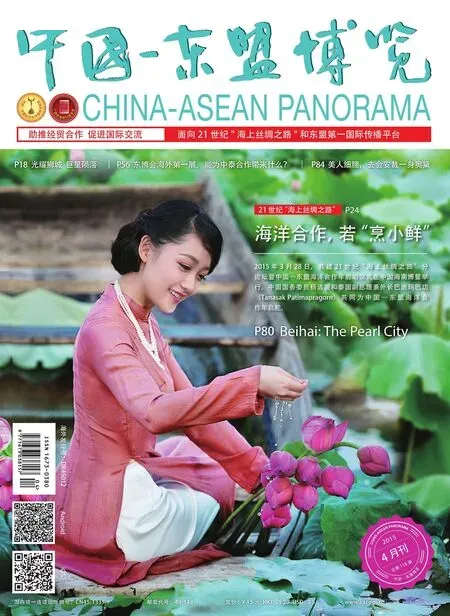2014 China-ASEAN Economic and Trade Cooperation Enjoys Diversifi ed Highlights and Brilliant Prospects
By ASEAN-China Centre (ACC)
2014 China-ASEAN Economic and Trade Cooperation Enjoys Diversifi ed Highlights and Brilliant Prospects
By ASEAN-China Centre (ACC)
ASEAN is China’s good neighbor, good partner and good friend. 2014 was the first year of the “Diamond Decade” of ASEAN-China cooperation and the second decade of ASEAN-China Strategic Partnership. As the cooperation between ASEAN and China continues to deepen and expand in the political, economic, social and cultural fi elds, bilateral economic and trade relationship has gone into a new area of an omni-directional, multilevel and deep-ranging pattern.
Political Leaders’ Meeting to Reach Consensus and Promote Cooperation
It is a common knowledge that political leaders’ meeting is the highest-level exchange between countries. It is a means of communication between the leaders, where numerous consensus are reached and a variety of cooperation initiatives are proposed, especially on those major issues facing each country. These initiatives are of great significance for the exchanges and cooperation among the countries concerned.
Frequent exchanges of visits between the leaders of ASEAN and China promoted the traditional friendly and practical cooperation between the two sides. In 2014, the leaders of ASEAN paid state visits and attended BOAO Forum for Asia, Conference on Interaction and Confidence -- Building Measures in Asia (CICA), China-ASEAN Expo, APEC Informal Meeting etc., expressing their strong wishes to further cooperate with China.
In the middle of November 2014, Chinese Premier Li Keqiang attended the ASEAN-related Summits held in Myanmar, and paid a state visit to Myanmar, which promoted the exchanges and cooperation as well as traditional friendship between China and ASEAN countries. He also announced at the 17th ASEAN-China Summit that the 21st Century Maritime Silk Road is to the benefit of ASEAN-China maritime cooperation. China proposed to designate 2015 as “ASEAN-China Year of Maritime Cooperation”, and expressed its willingness to work with ASEAN in implementing the projects backed by the ASEAN-China Maritime Cooperation Fund in 2014 and welcome them to actively join the fund projects in 2015.
Then Secretary-General of ACC Ma Mingqiang attended the 8th Pan-Beibu Gulf Economic Cooperation Forum and the 11th China-ASEAN Expo, showing that ACC attaches great importance to the construction of the 21st Century Maritime Silk Road and the upgraded version of ASEAN-China Free Trade Area.
Trade Volume Continues to Grow
In 2014, trade between ASEAN and China enjoyed steady growth, and trade scale with Myanmar, Laos and Vietnam increased rapidly. From January to December 2014, trade volume between ASEAN and China reached US$480.125 billion, with 8.23% increase on the basis of previous year. ASEAN was the third biggest trade partner of China, ranking after EU and the U.S., among which China’s exports was US$ 271.92 billion, while imports reached US$ 208.332 billion, increased by 11.36% and 4.41% respectively.
Regarding the specific countries, bilateral trade between China and Myanmar doubled with an increase of 146.03%. Trade volume with Laos and Vietnam increased by 31.87% and 27.54% respectively, much higher than 6.1% which is the average increase rate of China’s total trade with the world. China’s trade with Singapore and Thailand keep with a quite low increase which was 4.92% and 1.98% respectively. At present, ASEAN was the second biggest imports source and fourth biggest exporting markets of China.
Mutual Investment Enters a Stage of In-depth Development
The slowdown in China’s economy and economic transformation and upgrading of ASEAN economies influenced the development of bilateral trade to some extend. In 2014, mutual investment between ASEAN and China reached about US$130 billion, but increase rate of the actual investment slowed down and ASEAN’s FDI to China decreased by 24.53%. According to the statistics of Ministry of Commerce, the total FDI of Chinese enterprises reached US$35.21 billion till the end of December 2014, while the new added non financial FDI was US$5.88 billion, increasing by 2.5%. ASEAN’s FDI to China added up to US$91.74 billion among which newly added investment of 2014 was US$6.3 billion, decreasing by 24.53% on the basis of 2013.
China’s investment in ASEAN is extended to production and supply of coal, electricity and gas, transportation, commercial services, construction and project contracting, computer and information etc. Singapore, Malaysia and the Philippines are major ASEAN countries which invest in communications and transportation, tourism, real estate development, retail, insurance, finance and personal entertainment etc. in China.
As bilateral economic cooperation develops, economic interdependence between China and ASEAN will continue to consolidate. In this regard, both sides should seize the opportunities of building the 21st Century Maritime Silk Road, continue to deepen the existing areas of cooperation, expand cooperation in new areas and explore distinctive areas of cooperation, such as the halal food of China and Malaysia.
book=41,ebook=43

